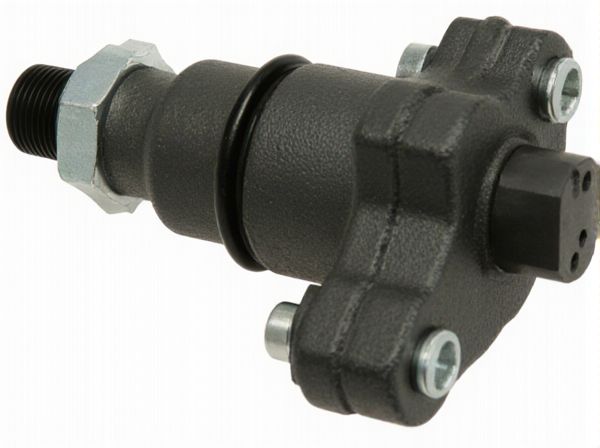
Photo illustration: Manual Proportioning Valve vs Automatic Proportioning Valve
Manual proportioning valves allow you to adjust brake pressure distribution between front and rear brakes by hand, offering precise control tailored to specific driving conditions. Automatic proportioning valves adapt brake pressure dynamically based on load and speed, providing consistent braking performance without manual intervention. Choosing between the two depends on your preference for customization versus convenience in brake system management.
Table of Comparison
| Aspect | Manual Proportioning Valve | Automatic Proportioning Valve |
|---|---|---|
| Function | Manually adjusts brake fluid pressure between front and rear brakes | Automatically modulates brake fluid pressure based on braking conditions |
| Operation | Driver or mechanic sets the valve adjustment | Sensors and valves adjust pressure in real-time |
| Performance | Fixed or manually tuned pressure distribution | Dynamic pressure control improves braking stability and safety |
| Installation | Simple, less costly installation, common in older vehicles | Complex, more costly, found in modern braking systems |
| Maintenance | Requires periodic manual adjustment and inspection | Minimal maintenance due to automatic regulation |
| Application | Suitable for basic brake systems without electronic controls | Ideal for ABS, traction control, and advanced safety systems |
Introduction to Proportioning Valves
Proportioning valves regulate brake fluid pressure to balance braking force between front and rear wheels, improving vehicle stability and safety. Manual proportioning valves require driver adjustment based on brake load and road conditions, while automatic proportioning valves adjust pressure dynamically using sensors and mechanical linkages. Effective proportioning valve selection enhances braking performance, reduces wheel lockup, and adapts to varying driving scenarios.
Understanding Manual Proportioning Valves
Manual proportioning valves allow precise adjustment of brake pressure distribution between front and rear brakes by hand, offering enhanced control during brake system tuning or repairs. These valves require driver or mechanic intervention to modify settings, making them ideal for custom applications where specific brake balance adjustments are necessary. Their simplicity and direct control contrast with automatic proportioning valves, which adjust pressure dynamically based on vehicle conditions.
Key Features of Automatic Proportioning Valves
Automatic proportioning valves regulate brake pressure dynamically based on vehicle load and driving conditions to ensure optimal braking performance and prevent wheel lock-up. These valves feature sensors and internal mechanisms that adjust fluid distribution between front and rear brakes without manual intervention, enhancing safety and responsiveness. Compared to manual proportioning valves, automatic valves improve brake efficiency and provide adaptive control tailored to real-time demands.
Operation Differences: Manual vs Automatic
Manual proportioning valves require driver input to adjust brake pressure distribution, typically via a knob or lever, allowing precise control over braking force in specific conditions. Automatic proportioning valves use hydraulic pressure sensors to modulate brake force dynamically, optimizing brake balance without driver intervention. The automatic system enhances safety by responding instantly to load and terrain changes, whereas manual systems depend on the operator's judgment for adjustment.
Performance Comparison in Brake Systems
Manual proportioning valves require driver adjustment to balance hydraulic pressure between front and rear brakes, which can lead to inconsistent braking performance under varying load conditions. Automatic proportioning valves use mechanical or electronic sensors to dynamically modulate brake pressure, ensuring optimal brake force distribution for improved stability and shorter stopping distances. The automatic variants enhance overall safety and performance, especially in modern vehicles with ABS and ESC systems.
Installation and Adjustment Requirements
Manual proportioning valves require precise hand adjustment during installation to ensure optimal brake balance and responsiveness, often necessitating specialized tools and experience to fine-tune pressure settings for varying load conditions. Automatic proportioning valves simplify installation by self-regulating brake pressure based on real-time input, eliminating the need for manual calibration and reducing the risk of improper adjustment. Consequently, automatic valves enhance safety and consistency, especially in vehicles with fluctuating loads or dynamic driving environments.
Maintenance and Longevity
Manual proportioning valves require regular adjustment and inspection to ensure consistent brake performance, with maintenance typically involving physical calibration and occasional seal replacements. Automatic proportioning valves adjust brake pressure in response to load variations, reducing the need for frequent manual intervention and generally offering longer service life due to self-regulating mechanisms. Proper maintenance of both valve types is crucial, but automatic valves often result in lower overall maintenance costs and improved longevity in demanding driving conditions.
Cost Considerations
Manual proportioning valves generally have lower upfront costs due to their simpler design and fewer components, making them an economical choice for basic braking systems. Automatic proportioning valves tend to be more expensive initially, but their ability to adjust brake pressure dynamically can reduce long-term maintenance costs and improve safety. When budgeting for brake system components, weighing the initial price against potential savings from enhanced performance and reduced wear is essential.
Applications and Suitability
Manual proportioning valves are ideal for specialized automotive brake systems requiring precise driver control and customization, commonly used in performance vehicles and racing applications. Automatic proportioning valves suit standard passenger cars and light trucks, providing consistent brake force distribution without driver intervention, enhancing safety and reliability in everyday driving conditions. Choosing between the two depends on the necessity for adjustable brake balance versus ease of maintenance and automated operation in specific vehicle applications.
Choosing the Right Proportioning Valve
Selecting the right proportioning valve depends on the specific braking system requirements and driving conditions. Manual proportioning valves allow for adjustable brake balance and are ideal for customized performance or racing applications where precise control is needed. Automatic proportioning valves provide consistent brake pressure distribution based on load and vehicle dynamics, enhancing safety and ease of use for everyday driving.
 caratoz.com
caratoz.com